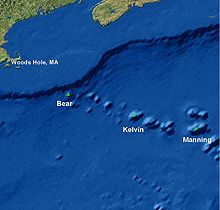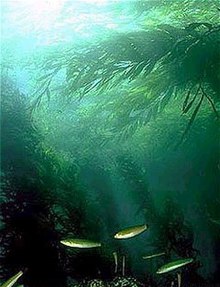Deep sea mountain
Seamounts or sea mounts (according to the English term of art also Seamounts are called) in its entirety located below sea surveys with a relatively small footprint (maximum a few thousand square kilometer) and a relatively steep slopes. The largest and most famous are located in the deep sea levels of the ocean basins and tower over their surroundings by around 1000 to 4000 meters. All of these large seamounts are active or extinct submarine volcanoes or former volcanic islands . Relatively prominent submarine elevations on the deep, outer shelf are often referred to as seamounts .
Origin and development
Deep-sea mountains usually arise at diverging plate boundaries ( mid-ocean ridges ) or within an oceanic plate through hot-spot volcanism: As a result of the movement of the oceanic plate over the more or less fixed hotspot, a whole chain of seamounts can arise. A chain of relatively close seamounts is also referred to as an aseismic ridge to distinguish it from the mid-ocean ridges ( alpha privativum from seismic , as these ridges, in contrast to the mid-ocean ridges, have no earthquake activity).
In contrast to islands, seamounts by definition do not protrude above the sea surface. A special case are the so-called guyots , geologically old seamounts, which were formerly islands subject to the erosive effect of the sea surf and therefore have a summit plateau. In the case of active volcanoes, geologically young seamounts can also develop into islands, as was seen at Surtsey and, among other things, expected at the seamount Loihi near Hawaii .
Seamounts are to be distinguished from oceanic plateaus , which, with a base area of tens of thousands of square kilometers, can reach significantly larger dimensions and can even carry mountains or islands.

Occurrence
The largest and most famous deep sea mountains are found in the deep sea plains of the oceans. They are often closely associated with hot spots . For example, there is an unusual accumulation near the Cape Verde Islands in the southeastern North Atlantic (see → Cape Verde Threshold ). It is not uncommon for seamount chains to draw a veritable trail across the ocean floor, the end point of which is an active volcanic island. The Hawaii-Emperor chain in the Northwest Pacific is a prime example of this .
In subduction zones where one continental plate dips below the other, such as the so-called Pacific Ring of Fire , these elevations can form obstacles to subduction. The descending plate (lower plate) remains stuck to the upper plate, so to speak, and this leads to particularly violent earthquakes and, if an entire seamount chain is subduced, to severe deformation of the upper plate.
Flora and fauna
Seamounts and their fauna have so far hardly been explored. However, the deep sea , in which there is absolute darkness, is home to a large number of animal species, for example cuttlefish such as the giant squid , which, however, are often characterized by low reproduction rates . In contrast to the surrounding ocean, deep-sea mountains are characterized by an increased occurrence of organisms, as they protrude into the zooplankton- rich zone up to a depth of 1000 meters and, due to their rocky surface, are colonized by sessile filter feeders (e.g. sponges , corals , arm pods) , Sea lilies and hair stars , moss animals ). If the top of the sea mountains reaches into the upper light-flooded zone, plants can also grow on them. Above all, large brown algae , the accumulations of which are referred to as " kelp forests ", use this habitat. Residents elevated location, seamounts are in danger by the fishing with huge bottom trawls to be fished out and killed.
Examples of deep sea mountains
- Eratosthenes deep sea mountain , near Cyprus, eastern Mediterranean
- Ferdinandea , Strait of Sicily, Mediterranean
- Marsili , Tyrrhenian Sea, Mediterranean
- Vema , South Atlantic off Cape Town
- Vavilov deep sea mountain , Tyrrhenian Sea, Mediterranean
- Anton Dohrn Seamount , Rockall Trough, North Atlantic
- Gorringe Bank , off Portugal, east central Atlantic
- Musicians Seamounts , North Pacific
- Tuscaloosa Seamount , near Hawaii, North Pacific
- Axial Seamount , Juan de Fuca Ridge, Northeast Pacific
- Tasmanian Seamounts , Southwest Pacific
- Lichtner Seamount , Southern Ocean
- Dallmann Seamount , Southern Ocean
literature
- Malcolm R. Clark, Derek Tittensor, Alex D. Rogers, Paul Brewin, Thomas Schlacter, Ashley Rowden, Karen Stocks, Mireille Consalvey: Seamounts, Deep-Sea Corals and Fisheries. UNEP World Conservation Monitoring Center, Cambridge 2006, ISBN 978-92-807-2778-4 ( PDF 1.1 MB).
- Barbara H. Keating, Patricia Fryer, Rodey Batiza, George W. Boehlert (Eds.): Seamounts, Islands, and Atolls (= Geophysical Monograph Series Vol. 43). American Geophysical Union, Washington, DC 1987, ISBN 0-87590-068-2 , doi: 10.1029 / GM043 .
- J. Anthony Koslow: Seamounts and the Ecology of Deep-Sea Fisheries. In: American Scientist. Vol. 85, 1997, No. 2, pp. 168-176.
- Henry William Menard: Marine Geology of the Pacific (= International Series in the Earth Sciences ). McGraw-Hill, New York 1964.
Web links
- Institute for Oceanography (Uni Kiel)
- Seamount ecosystems, OASIS project (PDF, English)
- Seamounts Online , database of the San Diego Supercomputer Center
- Expeditions in the Pacific in collaboration with the Monterey Bay Aquarium Research Institute (English)
- Seamounts on the Reykjanesrücken against Iceland (English)
- AB Watts: The deep structure of oceanic islands and seamounts (English)
Individual evidence
- ^ MY Ali, AB Watts: A seismic reflection profile study of lithospheric flexure in the vicinity of the Cape Verde Islands. In: Journal of Geophysical Research: Solid Earth. Vol. 108, No. B5, 2003, Item No. 2239, doi: 10.1029 / 2002JB002155
- ^ Karen Stocks: Seamount Invertebrates: Composition and Vulnerability to Fishing. In: Telmo Morato, Daniel Pauly (Ed.): Seamounts: Biodiversity and Fisheries (= Fisheries Center Research Reports. Vol. 12, No. 5). Fisheries Center, University of British Columbia, Vancouver 2004, pp. 17–24 (full volume, PDF 3.5 MB).


